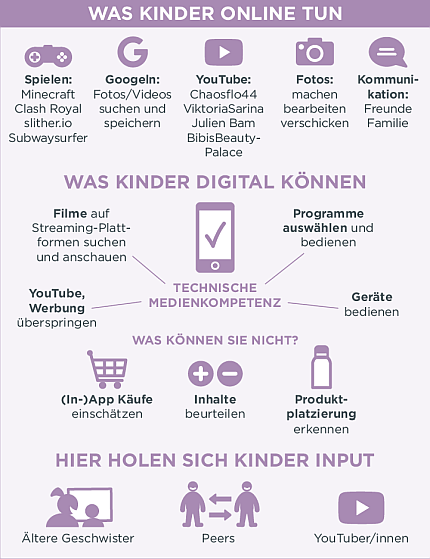Current study: Digital everyday family life at primary school age
Even children of elementary school age are using the Internet more and more intensively. Not only their parents' computers or smartphones are used for this. By the end of elementary school, far more than half of the children own their own devices. This early media consumption raises many questions: What are children doing on the Internet? What challenges are there in everyday digital family life? How can media education succeed?
Parents unsure, worried and often overwhelmed
Media education has become more demanding in the digital world. The fact that mothers and fathers in the age of mobile devices can no longer fall back on their own childhood experiences with television or the shared family computer triggers uncertainty. They are looking for orientation and answers to questions such as: What is appropriate media behavior? At what point is it appropriate for my child to have his or her own cell phone? How much time is he or she allowed to spend on the Internet? How can I limit Internet use in an age-appropriate way? How can I make my own devices safe in the short term if my children share them?
Rules and limits - there are no patent remedies
The spectrum of how parents try to master the challenge of media education ranges from "sticking one's head in the sand" to little control to banning the Internet. The good news is that anyone who is unsure about media education is by no means alone. After all, it is time-consuming and laborious. And there is no patent remedy. What is clear is that setting rules and boundaries is essential. The parents surveyed use a wide range of options: From time limits to content requirements (e.g., not publishing photos without consent) and technical restrictions (e.g., turning off the WLAN router) to rules in everyday family life (e.g., no media during meals).
It is important to find the right balance between control and trust in one's own children or respect for their privacy. In any case, it is crucial that parents themselves adhere to the agreed rules.
Internet at elementary school age: photos, YouTube, games
What do children like to do most on their smartphones or tablets? They play a wide variety of digital games (e.g. Minecraft, Clash Royal or slither.io), take photos and share them with friends (e.g. in WhatsApp), communicate with friends (also via WhatsApp), use Google to search for interesting content, such as pictures, and watch videos on YouTube. It also happens that YouTube stars have a high status in children's lives. Examples of these "influencers" are Chaosflo44, BibisBeautyPalace, Julien Bam and ViktoriaSarina.
The selectively high level of media competence among 6- to 9-year-olds is causing astonishment and concern among many parents. Children often prove to be very adept at operating devices and apps. A typical example of this is searching for and editing photos. They are also good at assessing which pictures they are allowed to publish. However, there is a great need for learning, for example, when it comes to evaluating content and recognizing sophisticated forms of advertising. Children also need support in perceiving their own limits and reacting to them in a sensible way. In the case of scary content, the little ones usually react by clicking away, turning their cell phones around or distracting themselves, i.e., largely by suppressing the content.
What annoys children most
Parents who do not adhere to agreed rules are among the biggest annoyances of the elementary school students surveyed. For example, when the adults themselves are too often distracted by the smartphone and the children have to compete for attention with the cell phone. Or when parents forward children's photos without being asked. Another major disruptive factor for 6- to 9-year-olds: Annoying advertising that they can't click away. Last but not least among the annoyances for children is exclusion when they can't join in the conversation or participate in their circle of friends because they don't have their own smartphone.
When discussing the first cell phone, some parents run the risk of lulling themselves into a false sense of security. Even without their own device, children can be confronted with frightening content among their friends, at school or in the family environment. Media education is therefore necessary even if children do not have their own smartphone or tablet.
Recognizing one's own limits
In contrast to later, it is still frequently observed in elementary school age that children can consciously recognize physical symptoms in themselves and sense when they are playing too long with smartphone & Co. Parents can support their children in recognizing these limits and offer alternative courses of action.
Parents required, school important support
Parents are required to actively take care of media education. This includes a basic knowledge of digital media, selecting age-appropriate content , and agreeing on and adhering to rules. Mothers and fathers should also encourage children not just to be "swayed" by digital media, but to use them productively and creatively - from an online invitation to a party to a self-made birthday video for grandma. Elementary schools are called upon to expand initiatives that have already been started and to make the competent and critical use of digital media part of the curriculum.
We would like to thank our partner Saferinternet.at for this article.
Further information:
- Saferinternet.at: Infographic on the study results
- Saferinternet.at: Study report "Digital media at primary school age"
- Saferinternet.at: press release from 01.02.2018 and downloads on the study
More on media education:

